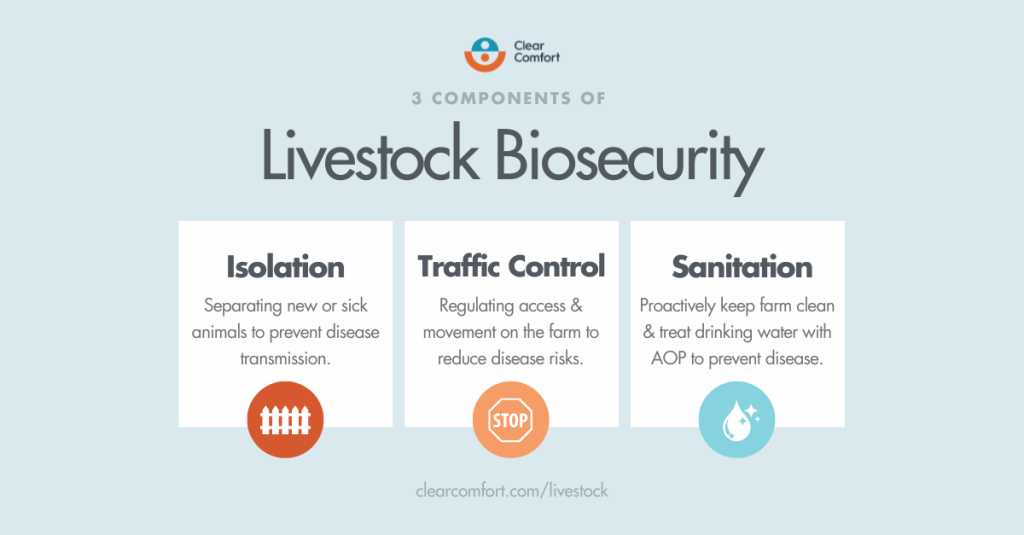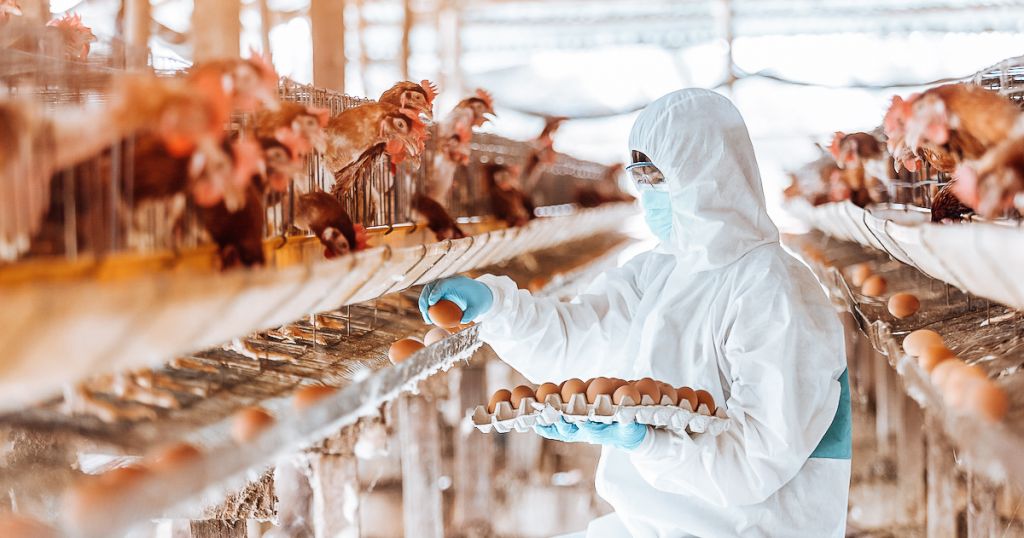Are you always looking to maximize your livestock production profits, but feel like you’re missing a crucial piece of the puzzle? You’re not alone. The world of livestock food production presents unique challenges, where the well-being of each animal impacts your hard-earned revenue. In turn, overlooking biosecurity is like leaving the farm gate wide open to trouble.
Biosecurity isn’t just about dodging diseases; it’s your secret weapon to keep profits climbing and your animals thriving. Whether you’re in the business of raising poultry, swine, cattle, sheep or managing a hatchery, a solid biosecurity strategy is your shield against all those invisible threats that can inevitably lurk on your farm.
In this comprehensive guide, we’ll dive into the core elements of livestock biosecurity, providing practical insights and actionable strategies for effective livestock management.
What is Biosecurity in Livestock?
Livestock biosecurity involves a series of proactive measures designed to prevent the introduction and spread of infectious diseases. This holistic approach includes new animal quarantine protocols, safe livestock drinking water treatment and overall farm hygiene. The primary goal is to ensure animal health and welfare, which directly impacts your farm’s productivity and profitable success.
How Disease Can Spread in Livestock:
- Wild and Domestic Animals: Diseases spread through contact with stray, domestic, or wildlife animals.
- Feed and Supplies: Contaminated feed or supplies introduce diseases when consumed or used.
- Drinking Water Sources: Drinking from or exposure to contaminated water sources can spread infections.
- Vehicles and Equipment: Using contaminated vehicles or equipment can transmit diseases across different areas of the farm.
- Human Interaction: People moving between farms or interacting with different animals can carry and spread diseases.
- Animal Waste: Contact with or proximity to infected animal waste can be a source of disease.
- New Additions: Introducing new animals without proper health checks can bring new diseases into the herd.

Why is Biosecurity Important in Livestock?
Biosecurity isn’t just a livestock buzzword. It’s your livestock production defense against diseases like Avian Influenza (AI). This disease not only devastates poultry and other bird populations, but also carries broader economic and industry welfare consequences.
How Biosecurity Benefits Livestock Food Production:
- Protects Animal Health: Lessens reliance on medical treatments and antibiotics, promoting natural livestock health and immunity.
- Economic Advantages: Improves production quality and profitability by preventing losses due to disease outbreaks.
- Regulatory Compliance: Ensures adherence to local and international livestock biosecurity regulations, avoiding potential fines and legal complications.
- Public Health and Safety: Prevents the spread of zoonotic diseases from animals to humans.
Understanding Poultry Biosecurity and Migration
Understanding migratory patterns, especially in birds, is crucial for effective disease control. The migratory periods, or “flyaway,” of rodents and birds play a significant role in the transmission of diseases. This reality has prompted farmers to use technologies and practices, like regulated hunting, to manage these risks. This is particularly vital during peak migration periods, where the risk of virus transmission through droppings and nasal secretions is heightened. For farmers and hunters alike, staying vigilant and understanding migratory periods is key to minimizing disease spread risks.
Mastering Livestock Biosecurity: Three Major Components
The health of your livestock can be both your morning motivation or what keeps you up at night. So, how do you protect livestock from the hidden threats that can quickly turn a healthy farm into a quarantine zone? The answer lies in the three major components of livestock biosecurity: isolation, traffic control and sanitation.
Let’s look at what these three biosecurity components mean for your livestock production.
1. Isolation: Your First Line of Defense
- Why It Matters: Introducing a new animal to your farm without proper precautions opens the doors to invisible threats. Isolation involves keeping livestock separate to prevent the spread of disease, acting as a security checkpoint to deter disruptions.
- How to Do It Right: Establish a quarantine zone for new or potentially exposed animals and a separate sick bay for those showing signs of illness. Both should be kept at a safe distance from your main herd, serving as a hospital specialized care unit.
- What’s the Result: This dual approach prevents the spread of unwanted health issues and minimizes the risk of contagion. By isolating at-risk animals, you’re not just protecting your livestock; you’re ensuring the uninterrupted operation of your production.
2. Traffic Control: Managing the Movements
- Why It Matters: Every visitor, vehicle or piece of equipment that enters your livestock premises could inadvertently bring in disease. Managing this traffic is like having a gatekeeper to oversee who or what gains access to your farm.
- How to Do It Right: Traffic control refers to managing and monitoring the movement of people, animals and equipment in and out of your farm to minimize infectious risks. Implement entry protocols, like footbaths, vehicle disinfection zones and regulated visitor access. It’s all about knowing and controlling who and what comes into contact with your animals.
- What’s the Result: Good traffic control keeps external threats outside your farm’s borders, maintaining a safe and secure environment for your animals.
3. Sanitation: Maximizing Health and Profitability
- Why It Matters: Pathogens love dirty, unkempt water and environments. Clean living conditions and livestock drinking water treatment prevent the occurrence and spread of disease.
- How to Do It Right: Adopt rigorous cleaning routines and consider livestock drinking water treatment, such as advanced oxidation process (AOP). This approach proactively safeguards your livestock health from the inside out from a broad spectrum of pathogens and diseases.
What’s the Result: The right sanitation ensures peace-of-mind. Similar to hygienic living conditions, treating livestock drinking water is vital for biosecurity. Hydroxyl-Based AOP livestock drinking water treatment has opened new doors for producers seeking to improve protein yield, feed conversion and death loss.
What exactly does Hydroxyl-Based AOP livestock drinking water treatment do?
-
- Turns even the poorest quality well water to clear, pristine drinking water
- Increases water consumption with better taste and odor
- Aid digestion, nutrient feed uptake and growth rates
- Destroy pathogens, viruses and chlorine-resistant contaminants
- Protects equipment from scaling, fouling and biofilm
- Minimizes the need for toxic chemical use
- Removes heavy metals from water

How to Create a Comprehensive Biosecurity Plan
Securing your farm’s future requires a proactive and predictable biosecurity plan. This plan is your blueprint that not only prepares you for disease outbreaks but also aligns with regulatory standards. It’s all about being proactive rather than reactive.
Follow this detailed guide to formulate a biosecurity plan that integrates essential components of protection: physical security, personnel reliability and information security.
1. Assessment of Farm Risks and Needs
Begin by assessing the unique risks your farm faces. Tailor your biosecurity measures to your farm’s specific risks, factoring in the type of livestock, farm size, and location.
2. Physical Security & Isolation Protocols
Craft protocols for isolating new, ill, or potentially exposed animals, including designated quarantine zones. These measures act as physical barriers, preventing the spread of disease within your herd.
3. Traffic Control Measures
Implement stringent control measures to monitor and manage the movement of people, animals, and equipment onto and off the farm. This includes checkpoint controls, visitor logs, and disinfection stations, ensuring a secure and controlled environment.
4. Sanitation and Livestock Drinking Water Treatment
Outline a comprehensive sanitation plan. This includes regular cleaning and disinfecting of facilities, equipment, and transportation vehicles. Remember, water is at the core of your livestock health. Ensure your livestock’s health with AOP-treated water, enhancing taste, intake and overall well-being.
5. Personnel Reliability, Staff Training and Education
Invest in educating your team about biosecurity principles, disease recognition, and emergency protocols. Regular, in-depth training ensures that every team member is capable and knowledgeable in upholding your farm’s biosecurity standards.
6. Emergency Plan for Disease Outbreaks
Create a detailed emergency response plan for handling disease outbreaks, including quarantine procedures and steps for notifying veterinary authorities.
7. Regular Health Checks
Implement a schedule for regular health checks of your livestock by a qualified veterinarian. Early detection of diseases with livestock vet services is key to effective biosecurity.
8. Information Security, Documentation and Compliance
Maintain meticulous records of all biosecurity practices and ensure strict adherence to local and national regulations concerning livestock health. Safeguard your farm’s data and information from unauthorized access or breaches.
9. Review and Update the Biosecurity Plan Regularly
Continuously evaluate and update your biosecurity plan to reflect changes in farm operations, new health information or emerging risks.
The Big Takeaway: Keep Your Livestock Healthy
Remember, a comprehensive biosecurity plan is not a static document, but a strategy that adapts to your livestock production. It’s about nurturing a safe and healthy environment where your livestock can thrive, ensuring your farm’s profitability and productivity. By taking these proactive steps, you’re not just preventing diseases; you’re creating an environment where your livestock can thrive.
So, embrace these principles and a well-crafted biosecurity plan with dedication and watch your farm thrive. By adopting effective biosecurity measures, you’re securing peace-of-mind and time to focus on what truly matters most.








